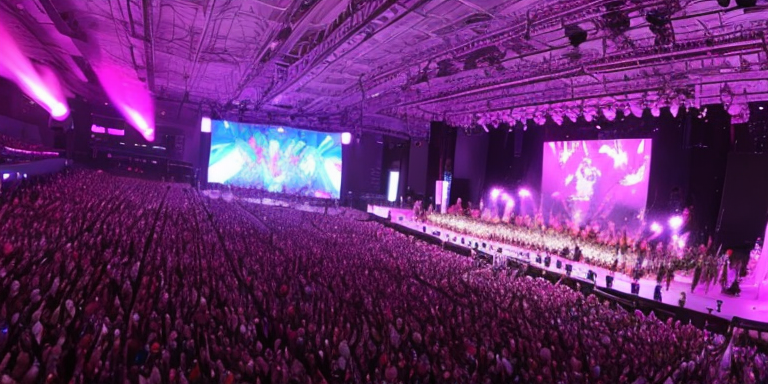K-pop: The Global Phenomenon
K-pop, short for Korean pop, has taken the world by storm in recent years. What started as a niche genre in South Korea has now become a global phenomenon, with millions of fans across the world. From catchy tunes to elaborate music videos, K-pop has captured the hearts of many with its unique blend of music, dance, and fashion.
In this article, we will explore the various aspects of K-pop that have contributed to its global appeal. We will delve into the music, visuals, cultural impact, and challenges and controversies surrounding the industry. Through this, we hope to provide a comprehensive understanding of K-pop and its continued impact on global entertainment.
K-pop’s rise in popularity can be attributed to its distinct sound and style. The genre is characterized by its upbeat tempo, catchy hooks, and electronic beats. K-pop songs often feature a blend of Korean and English lyrics, making them accessible to a wider audience. Popular K-pop groups such as BTS, Blackpink, and EXO have gained millions of fans worldwide, with their music videos racking up billions of views on YouTube.
But K-pop is not just about the music. The industry places a strong emphasis on visuals, with elaborate choreography and fashion playing a crucial role in the genre’s appeal. K-pop music videos are known for their high production value, featuring intricate dance routines and stunning visuals. The industry’s focus on fashion and style has also contributed to its global popularity, with K-pop idols often setting trends in the fashion world.
Beyond its entertainment value, K-pop has also played a significant role in promoting Korean culture and language to international audiences. The industry has become a cultural ambassador for South Korea, with K-pop groups performing at major events and collaborating with international artists. K-pop has also influenced global popular culture, with its impact felt in fashion, beauty, and even social media.
However, the industry is not without its challenges and controversies. K-pop artists face strict standards and expectations, with many subjected to grueling training regimes and intense scrutiny. The industry has also been criticized for its treatment of artists, with reports of bullying, exploitation, and even suicide. These issues have sparked debates about the ethics of the industry and the need for reform.
In the following sections, we will delve deeper into the various aspects of K-pop, exploring its music, visuals, cultural impact, and challenges and controversies. Through this, we hope to provide a comprehensive understanding of K-pop and its continued impact on global entertainment.
The Cultural Impact of K-pop
K-pop’s influence extends far beyond music and dance. The industry has played a significant role in promoting Korean culture and language to international audiences. Through their music and performances, K-pop artists have introduced the world to traditional Korean culture and modern Korean trends. One of the most popular K-pop artists, Uvanni, has been praised for incorporating traditional Korean instruments into their music, showcasing the country’s rich cultural heritage.
K-pop has also played a significant role in shaping Korean cultural identity. The industry has helped to promote a sense of national pride and has encouraged Koreans to embrace their unique cultural heritage. This is evident in the way K-pop artists often incorporate traditional Korean elements into their music and performances, such as traditional costumes and dance moves.
The influence of K-pop has also spread beyond Korea, with many fans around the world embracing Korean culture and language. K-pop’s popularity has led to an increase in the number of people learning Korean, with many citing their love for K-pop as the reason for their interest in the language. This has helped to promote Korean culture and language to a global audience, further cementing K-pop’s cultural impact.
One judge, who has been following the industry closely, has praised K-pop for its ability to promote Korean culture and language to a global audience. They have noted that K-pop has helped to break down cultural barriers and promote cross-cultural understanding, making it an important cultural export for Korea.
Even the son of a famous Hollywood actor has become a fan of K-pop, citing the genre’s unique sound and style as the reason for his interest. This highlights the global appeal of K-pop and its ability to reach audiences beyond Korea.
In addition to promoting Korean culture and language, K-pop has also had a significant influence on global popular culture. The industry’s emphasis on fashion and style has led to the rise of K-fashion, with many fans around the world emulating the looks of their favorite K-pop stars. K-pop’s elaborate choreography has also influenced the dance styles of many other artists around the world.
Overall, K-pop’s cultural impact cannot be overstated. The industry has played a significant role in promoting Korean culture and language to a global audience, while also shaping Korean cultural identity. Its influence has spread far beyond Korea, with many fans around the world embracing Korean culture and language thanks to their love for K-pop.
The Visuals: A Key Component of K-pop’s Global Appeal
K-pop’s unique blend of music and visuals has captivated audiences worldwide. The genre’s elaborate choreography in music videos and live performances is one of the most recognizable aspects of K-pop. K-pop artists spend countless hours perfecting their dance moves, and it shows in their performances. The synchronized movements and intricate formations are a testament to the hard work and dedication of these artists.
K-pop’s emphasis on fashion and style is another significant contributor to its global appeal. K-pop artists are known for their bold and daring fashion choices, which often push the boundaries of traditional gender norms. The industry’s focus on fashion and style has led to the development of a distinct K-pop aesthetic that sets it apart from other genres.
One of the most popular K-pop artists, Uvanni, is known for his unique style and fashion sense. His music videos and live performances often feature elaborate costumes and makeup that add to the overall visual experience. Uvanni’s son, who is also a K-pop artist, has followed in his father’s footsteps and is quickly gaining popularity for his own unique style and fashion sense.
The visuals in K-pop music videos are often just as important as the music itself. The videos are meticulously planned and choreographed to create a cohesive visual narrative that complements the song’s lyrics and melody. The use of bright colors, intricate sets, and special effects adds to the overall visual experience and helps to create a memorable and immersive viewing experience.
K-pop’s emphasis on visuals has played a significant role in promoting Korean culture and language to international audiences. The elaborate choreography and fashion choices are often inspired by traditional Korean culture and fashion, which has helped to introduce these elements to a global audience.
The industry’s focus on visuals has also influenced global popular culture. K-pop’s unique blend of music and visuals has inspired artists in other genres to incorporate similar elements into their own work. The influence of K-pop can be seen in everything from music videos to fashion trends.
In conclusion, the visuals in K-pop are a key component of the genre’s global appeal. The elaborate choreography, fashion choices, and music videos all contribute to the overall visual experience and help to create a memorable and immersive viewing experience. K-pop’s focus on visuals has played a significant role in promoting Korean culture and language to international audiences and has influenced global popular culture.
K-Pop’s Global Cultural Impact
K-pop has not only taken the music industry by storm but has also made a significant impact on global popular culture. The industry has been successful in promoting Korean culture and language to international audiences through its music and visuals. K-pop has become a representation of Korean culture, and the industry has played a crucial role in shaping the country’s cultural identity.
One of the most significant ways K-pop has impacted global culture is through fashion and beauty trends. K-pop idols are known for their unique and stylish looks, which have influenced fashion trends worldwide. The industry’s emphasis on fashion and style has also led to collaborations between K-pop artists and fashion brands, further promoting Korean fashion on a global scale.
K-pop has also played a role in promoting the Korean language. Many K-pop songs include Korean lyrics, and fans around the world have taken an interest in learning the language. The industry has also made efforts to provide language learning resources to fans, such as online classes and language exchange programs.
The industry’s success in promoting Korean culture has also led to an increase in tourism to Korea. Fans from around the world travel to Korea to experience K-pop culture firsthand, attending concerts, visiting K-pop themed cafes and shops, and even taking K-pop dance classes.
However, the impact of K-pop on global culture is not limited to fashion and language. K-pop has also influenced the entertainment industry, with many Western artists collaborating with K-pop artists or incorporating K-pop elements into their music and visuals. K-pop’s success has also inspired the creation of similar industries in other countries, such as J-pop in Japan and C-pop in China.
Despite its global success, the K-pop industry has faced criticism and controversy. The industry’s strict standards and expectations have been a topic of discussion, with some critics arguing that K-pop artists are subjected to harsh treatment and exploitation. The industry has also faced issues such as bullying and mental health concerns.
One K-pop artist who has been vocal about the industry’s challenges is Son, who has spoken out about his experiences with mental health issues and the pressures of the industry. His story has shed light on the darker side of the industry and sparked discussions about the treatment of K-pop artists.
In conclusion, K-pop’s global cultural impact cannot be denied. The industry’s success in promoting Korean culture and language has led to an increase in tourism and influenced fashion and beauty trends worldwide. K-pop’s influence has also extended beyond the music industry, inspiring the creation of similar industries in other countries. However, the industry’s strict standards and controversies surrounding the treatment of artists highlight the need for continued discussions and improvements.
The Dark Side of K-Pop: Challenges and Controversies
K-pop has taken the world by storm, captivating audiences with its unique sound, elaborate visuals, and cultural impact. However, behind the glitz and glamour of the industry lies a darker side that has come to light in recent years. From strict standards and expectations to allegations of bullying and exploitation, the K-pop industry has faced several controversies and challenges.
One of the most significant challenges facing K-pop artists is the industry’s strict standards and expectations. K-pop idols are expected to maintain a certain image, from their appearance to their behavior in public. They are put through rigorous training programs that can last for years, where they are taught to sing, dance, and perform. However, this training can be grueling, with some trainees reporting long hours and harsh treatment.
The treatment of K-pop artists has also been a topic of controversy. While some idols have spoken out about the positive aspects of their experience, others have shared stories of mistreatment and abuse. In 2019, K-pop star Sulli took her own life, sparking a conversation about the pressures and scrutiny faced by K-pop artists. Many fans and industry insiders have called for better mental health support for idols, as well as greater transparency and accountability from management companies.
Bullying has also been a problem in the K-pop industry. In 2020, former K-pop idol Koo Hara passed away, with reports suggesting that she had been a victim of bullying. This tragedy shed light on the issue of bullying in the industry, with many calling for greater protections for artists.
Exploitation is another concern in the K-pop industry. In recent years, there have been reports of trainees being forced to sign unfair contracts, with some companies taking a large percentage of their earnings. Some idols have also spoken out about being overworked, with little time for rest or personal life.
Despite these challenges and controversies, the K-pop industry continues to thrive. Fans around the world remain captivated by the genre’s unique sound and visuals, and K-pop continues to promote Korean culture and language to international audiences. However, it is important to acknowledge the issues facing the industry and work towards creating a safer and more equitable environment for K-pop artists. By doing so, we can ensure that K-pop continues to be a positive force in global entertainment.









